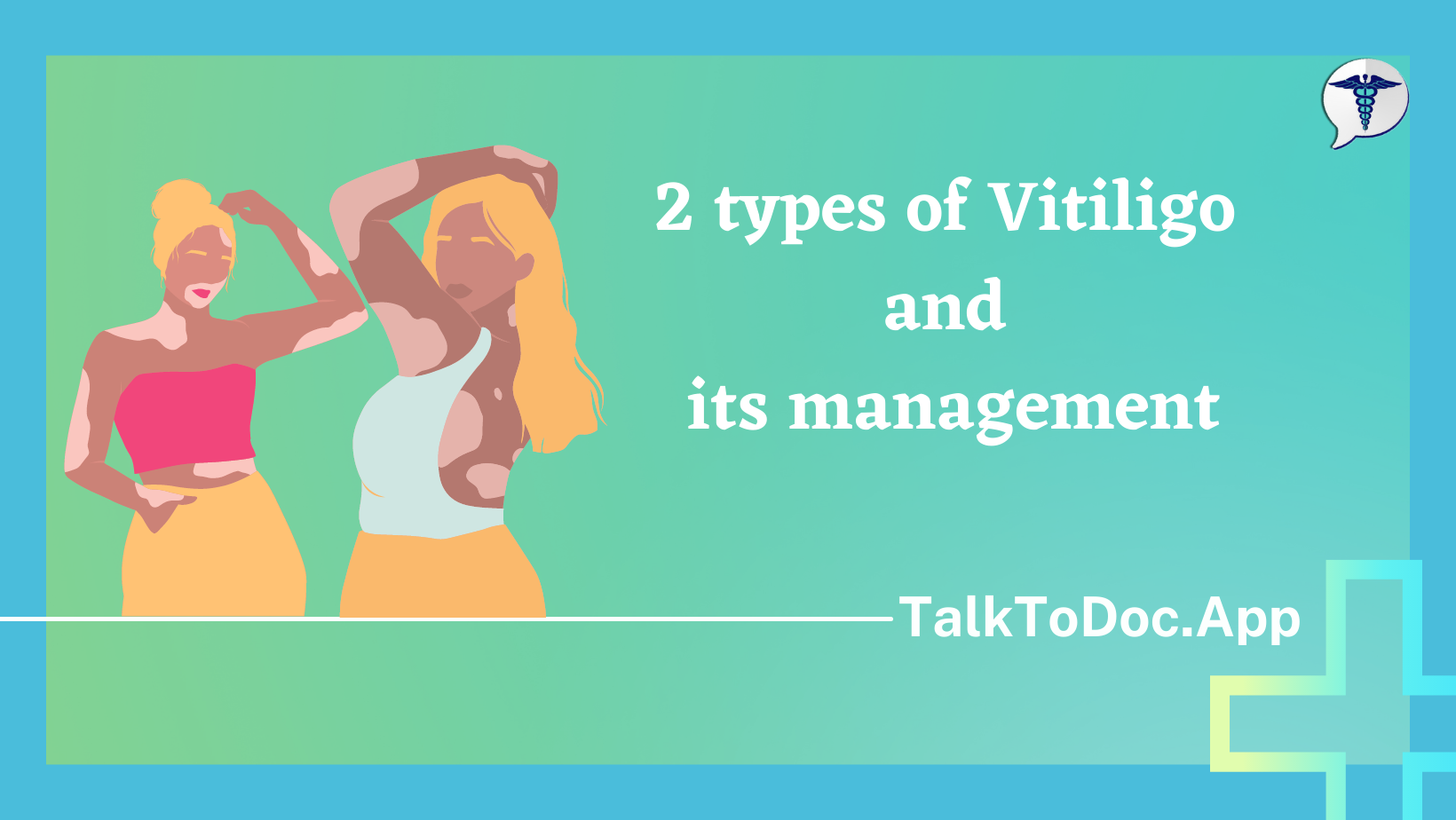2 types of Vitiligo
Vitiligo is a common slowly progressive acquired condition caused by the focal loss of melanocytes within the skin resulting in the development of hyperpigmentation.
It is important for us to know in detail about it and to know the cause of Vitiligo, its different types and how to manage it. People with a pigmentary disorder of skin should keep this in mind, it’s just a disorder like any other and hence should seek medical care as soon as possible.
Classification of Vitiligo
Broadly it is classified into 2 types of Vitiligo types depending upon the area it affects.
- Localized
- Generalised
Localized type of Vitiligo
- Focal vitiligo: one or more macule in one areas not clearly in a segment.
- Segmental Vitiligo: Number of macule in unilateral segment of the body (stopped abruptly at midline).
- Mucosal vitiligo: Affects lips, oral cavity and genitalia.
Generalized type of vitiligo
- Acrofacial vitiligo: lesions on the acral( hand and feet) and face (perioral).
- Vitiligo vulgaris: multiple macules bilaterally symmetrically scattered.
- Lip tip vitiligo: tips of digits and lips only.
- Mixed Vitiligo: Any combination of the above.
- Universal vitiligo: Complete or near complete depigmentation of the body.

Etiology of Vitiligo
The aetiology is idiopathic but many believe in its autoimmune nature. Vitiligo is caused by the lack of a pigment called melanin in the skin. Melanin is produced by skin cells called melanocytes, and it gives your skin its colour.
In vitiligo, there are not enough working melanocytes to produce enough melanin in your skin. This causes white patches to develop on your skin or hair. Vitiligo can start at any age but usually appears before age 30. Vitiligo is not necessarily inherited. However, about 30% of people who have vitiligo do have at least one close relative who also has vitiligo.
Vitiligo can be seen in association with Autoimmune thyroiditis, Addison’s disease Pernicious anaemia, Diabetes mellitus.
Vogt Koyanagi Harada syndrome:
Vitiligo, poliosis, Uveitis, alopecia and hearing difficulties.

Clinical Features of Vitiligo
A person suffering from hypopigmented macule or patch at any site of the body.
Since Vitiligo Vulgaris is the most common patient has bilaterally symmetrical lesions on both sides with the sharp demarcation of edges.
If in a patch, hair follicles are also white it is called leukonychia it has a poor prognosis.
Sensation in the depigmented patch is normal.
Koebner phenomenon/Isomorphic phenomenon can be seen, it is an immune-mediated reaction that causes the appearance of new skin lesions on previously unaffected skin secondary to trauma.

Wood’s light examination shows the contrast between pigmented and non pigmented skin.
Management of Vitiligo
Though the treatment often is unsatisfactory, since there is no cure for it. The goal of medical treatment is to create a uniform skin tone by either restoring colour (repigmentation) or eliminating the remaining colour (depigmentation). 5 Acne Myths You believed
It is important to protect the patch from excessive sun exposure with clothing or sunscreen to avoid sunburn.
1.Topical treatment for Vitiligo
Topical corticosteroids, Immunomodulators like tacrolimus 0.1% ointment is quite effective, especially for the facial region.
2.Phototherapy
- PUVA therapy: Topical soralen plus ultraviolet A phototherapy, is most effective repigmentary treatment available for non segmental generalized type of Vitiligo.
- NB-UVB therapy: Narrow band ultraviolet B phototherapy, It is treatment of choice for active generalized vitiligo.
3.Systemic treatment for vitiligo
- Psoralen & Ultraviolet A.
- Corticosteroids.
- Immunomodulators like Azathioprine, cyclosporin, levamisole.
- Phenylalanine.
- Khellin.
- Antioxidants like Glutathione.
4.Surgical treatment for Vitiligo
- Punch Grafting.
- Split skin thickness grafting.
- Blister grafting.
- Melanocyte culture and transplantation.
- Tattooing.
Apart from the above management, people suffering from Vitiligo must have a supportive circle of family & friends. vitiligo should not be considered as a stigma, it is NON CONTAGIOUS and comes with a slim risk of it passing on to our future generation if any one of the parents has vitiligo. It is time to debunk common myths regarding vitiligo and stay educated.
It’s important to note that vitiligo management varies for each individual, and the treatment approach should be tailored to their specific needs. Consulting with a dermatologist or a healthcare professional experienced in treating vitiligo is crucial for proper diagnosis and personalized management.
